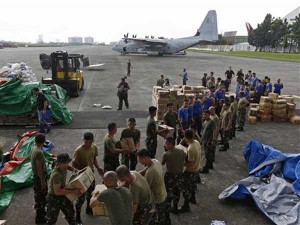As millions of Filipinos prepare to mark Christmas in makeshift homes in typhoon-hit Eastern Visayas, aid workers are spending simple yet meaningful holidays with them in areas its residents are determined to rebuild.
A number of local and foreign workers of the United Nations and other partner agencies are sticking it out in the disaster zone despite a one-day break Wednesday in a display of solidarity with those who had lost loved ones, homes and most everything they valued.
“Most of my colleagues, including myself, will forfeit the Christmas break because they are too far away from their families who are scattered in South Africa, in Pakistan, in Geneva, in New York and so on,” said Bernard Kerblat, the Philippine representative of the United Nations High Commissioner for Refugees (UNHCR).
“Given the trail of destruction from Guiuan and Victory Island, all the way to Busuanga (in Palawan), it’s going to be a sad Christmas for millions, but we don’t forget them. And we stand side by side with them in solidarity, given the plight which is affecting them, and we take that very close to our hearts, with our desire to support them,” Kerblat told the Inquirer in an interview.
Since the emergency, the United Nations has doubled personnel for its 14 agencies working in the Philippine disaster zone, and is continuing to hire more.
Mounting a massive response to the Level 3 emergency, highest in its disaster scale, the United Nations enlisted 500 more personnel—experts in various aspects of emergency response—from the Philippines and around a world in a “surge” of deployment to bring in “very high level” support here, said Luiza Carvalho, the United Nations humanitarian coordinator in the country.
The additional staff complement is expected to stay up to three months, Carvalho said, as the United Nations continues to work with government and nongovernment organizations to help typhoon survivors get back on their feet and reestablish housing and critical infrastructure, livelihood, health and education systems, among others.
Currently, the United Nations maintains a still growing staff of 468 foreign workers and 470 Filipino staff here, including the recent arrivals.
“This is the first Level 3 disaster in the Philippines, meaning the UN is supposed to respond very fast, expanding capacities, mobilizing resources and really being able to deploy resources and personnel very soon to the field,” Carvalho said in a separate interview.
“We follow the size of the challenge in front of us. So in this case the challenge is huge, it’s enormous,” said the official, describing the disaster that claimed more than 6,000 lives and affected some 14 million people, 4 million of whom were displaced.
For the UNHCR alone, 54 international staffers are currently spread across typhoon-hit villages in the cities of Cebu, Roxas, Tacloban and Ormoc, in the towns of Borongan and Guiuan, and in camps for the displaced in Cotabato City, Kerblat said.
And many among them will stay put in the disaster zone despite their break Wednesday.
“We want to respect the survivors also who want to celebrate Christmas. But business continues almost on a 24-hour basis. We need to continue pushing trucks, pushing supplies,” Kerblat said.
He said a fresh shipment of relief supplies from the UNHCR would reach the disaster zone by sea within the first two weeks of January, with a total of 65 40-foot containers carrying blankets, plastic sheets and chainsaws arriving in severely hit towns.
Kerblat said the chainsaws would be distributed to survivors so they could salvage coconut trees felled by the typhoon and turn them into lumber for rebuilding their homes.
“Instead of letting the trees rot in the water, we’re going to empower the survivors with chainsaws so they can cut these coco timber and make frames to reconstruct their houses, and to help each other out in the spirit of bayanihan in the most affected barangays,” he said.
The shipments will include 800,000 pieces of clothing for survivors and some 2,000 mattresses to be distributed in hospitals, the official said.
“This is what everybody is trying very hard to do—to make life slightly more comfortable. [And it] starts with a friendly handshake, starts with a hug, starts with a smile, starts with the acknowledgement of the plight of these people. And that is a beginning,” Kerblat said.
He commended how Filipinos looked out for their kababayan in the aftermath of Yolanda and called on the nation to sustain the support, as the typhoon survivors would need help for the long haul.
“It is incumbent upon all of us to do a second wave: a massive tidal wave of solidarity in order to empower these communities to regain their future and dignity, [and get back] on their feet,” Kerblat said.
“That is what matters at this point in time, much more than this exercise of budgeting, of planning, of what is entailed in terms of reconstruction, which is going to be massive,” he said.
RELATED STORIES:
Muslim refugees in Zamboanga observe Christmas with hope
Brothers build Christmas lantern to light up celebration in Tacloban
‘Yolanda’ survivors welcome Christmas
